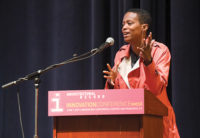Architectural Record Managing Editor Beth Broome (far left) led a panel discussion on the global influence of Mexico's new generation of architects with (from left to right) Michel Rojkind, Tatiana Bilbao, Jorge Gracia, and Fernanda Canales.
Architectural Record’s first Innovation Conference outside of New York City was aptly held in Los Angeles, a city known for blurring boundaries between urbanism, architecture, and the landscape. The conference was held on Thursday at Frank Gehry’s Walt Disney Concert Hall, itself an amalgam of art, science, and technology.
In her opening keynote, Jeanne Gang, principal of Chicago-based Studio Gang Architects, focused on the concept of flow in her projects and practice, from the firm's studies of Chicago’s river system, to the re-use of building materials, to the flow of data, and how design can be fine-tuned by an overlay of quantitative information. Three of Gang's Chicago projects—the Living Building Challenge-certified National Resources Defense Council headquarters, the WMS Boathouse at Clark Park, and the Northerly Island Park—illustrated these concepts.
Architecture’s role as a connective tissue came up again and again throughout the day. In a joint presentation, Brad Cloepfil, principal of Allied Works Architecture, and artist Doug Aitken showed how architecture works with art to extend an idea. In his installations, Aitken says he strives to create “art that leads you through the architecture” and “a condition where architecture is continuously reinventing itself.” The duo has married art and architecture on a range of projects—from residential lofts in New York City to the Seattle Art Museum.
During a presentation on the Cornell Tech Roosevelt Island campus, architects Marion Weiss and Michael Manfredi explained how their squat design for the Corporate Co-Location building inspires connections to the river and the city, while encouraging creative friction between the graduate students and tech companies that will share the space. Weiss and Manfredi’s design also responds to Thom Mayne’s tall, academic building nearby. Mayne went into detail about the mechanical systems that make his projects both memorable and efficient. “More and more, architects will become engaged in the product itself,” he declared. His firm, Morphosis, collaborated with Holcim to invent a precast concrete block that Mayne used to sheath the Perot Museum of Nature and Science in Dallas, creating an undulating, geologic pattern.
In a discussion led by Los Angeles Times architecture critic Christopher Hawthorne, the panel of landscape architects—Walter Hood of Hood Design Studio, Chris Reed of Stoss Landscape Urbanism, and Ken Smith of Ken Smith Workshop—hashed out the ways landscape architecture has “complexity baked into it.” For Hood, landscape is about “cultivating place and people” through the design of natural space. Reed added that landscape is “catalytic,” and can help take on “bigger challenges of the future, such as climate change.”
During a panel on Mexico’s vibrant community of young practitioners, architects Tatiana Bilbao, Fernanda Canales, Jorge Gracia, and Michel Rojkind all agreed that infrastructure to support architecture in Mexico still needs to be strengthened, but that absence also affords them the opportunity to follow their creativity. “There is a big opportunity for young architects in Mexico, which may not be true of other countries,” said Bilbao. The group’s biggest hurdles occur when marrying prevalent traditional methods with more forward-thinking designs. Rojkind recalled how he once visited a contractor only to be introduced to his “human CNC machines.”
The day ended with a meditative presentation of projects by Thomas Phifer, inspired by artists like Carl Andre and Roni Horn. His 150,000-square-foot expansion of the Glenstone Art Museum in Potomac, Maryland, is a series of pavilions, each devoted to a single artist. Noting the way glass comes to life in daylight, Phifer’s Corning Museum of Glass expansion has a translucent roof that allows a generous amount of daylight in the gallery space. His design for a sinuous, brick-laden Madison, Wisconsin, house echoes the same curves of Thomas Jefferson’s serpentine walls at the University of Virginia. Phifer’s presentation was a reminder that in the hurly burly of this need to connect, there should also be time to regroup. He says, “It is about a quieting experience, about looking and pausing.”





Post a comment to this article
Report Abusive Comment